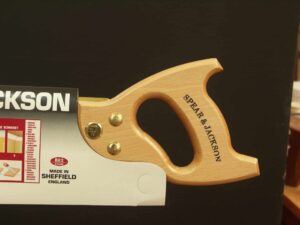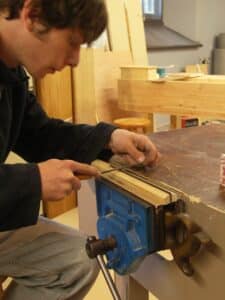John’s saw continued
John sharpened his first saw and guess what? It cuts! Setting comes next and I will teach him the hammer-and-nail-punch (nail set US) method as this is fast, accurate and highly versatile. This saw is smaller and has fairly small teeth, which is a harder saw to start practicing on, but he did it. It quickly becomes an intuitive skill and usually I sharpen my saws to task and to wood. What does that mean? It’s all in my new book actually and it comes as a result of my sharpening thousands of saws. Saws have to be sharpened for dovetailing, tenon cutting, ripping and tangential cutting cutting thin wood and cutting thick wood, cutting vertically in the vise and cutting horizontally using power-thrust techniques on saw horses. The physics dictate certain sharpening strategies and that’s what students get when they come to my woodworking courses at New Legacy.

It takes four minutes to sharpen a saw and four minutes to set one. They can be sharpened for a wide range of tasks and woods and you must realise this when you learn to sharpen. How many of you know that the angle of the saw handle in relation to the line of the teeth has a direct impact on how the teeth must be sharpened? How many of you realise that the handle has a central point of thrust that engages or disengages the teeth from the cut. These are all factors that determine how a saw is sharpened. Try cutting oak with one saw and then try the same saw doing the same task say in cherry. The results are markedly different yet sharpening to task and wood makes all the difference.
Spear and Jackson, in the days when the original saw makers owned their business, knew this. Their saws paralleled Henry Disstons and so too did many of the early makers who peaked saw making to its zenith of perfection in the last half of the 1800’s. In the late 1950′ and early 60’s we saw the diminishing standards of the then modern-day saw makers. The saw here shows the deterioration. Imagine that any company could possibly produce something like this. But, there is one redeeming fact. The materials used to produce this saw are good quality. Use it as a kit if you like. Abrade the steel to polish it, do the same to the brass back and reshape the handle to suit your hand. This saw has a solid brass back, good beechwood handle, good spring steel. The lack between maker and user has progressively deteriorated through the decades. One day perhaps British saws will once again equal the standards of the old makers past or those of the north American makers today. www.adriatools.com www.lie-nielsen.com www.veritas.com are three makers I can recommend.



Do you have instructions on how to set a saw with a punch and nail in your blogs. Thanks